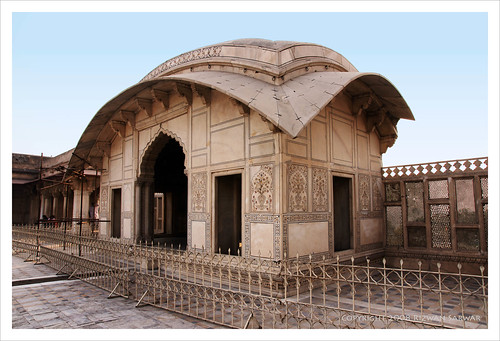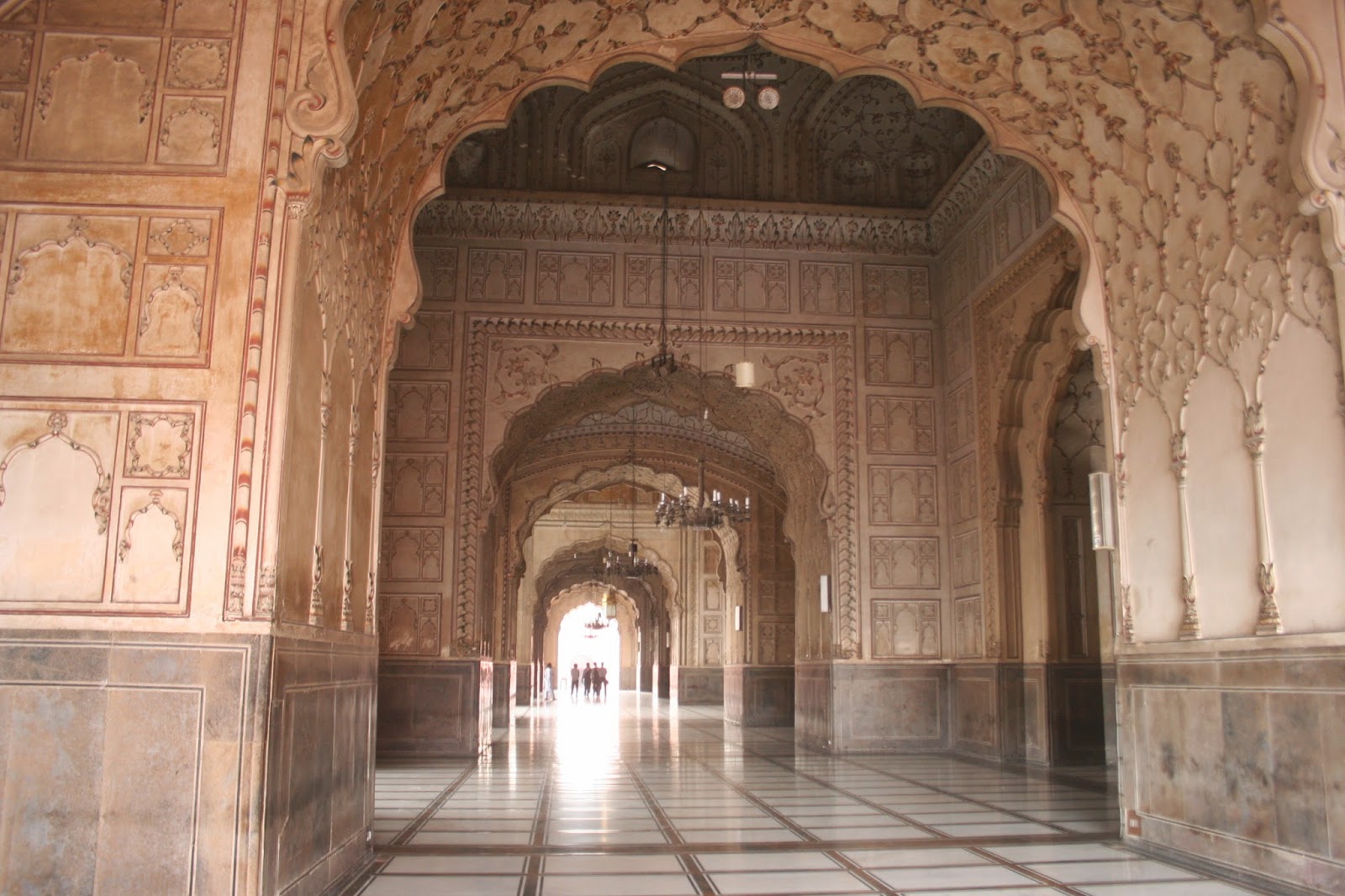
 Also known as Shahi Qila, and the citdel of Lahore, at 20 hectares in size, the Lahore Fort was built during the era of the Mughal Khan Akbar (1556-1605) and added to by various different subsequent rulers, although this was not its first incarnation -- it was "built, damaged, destroyed, rebuilt and restored" before this.
Also known as Shahi Qila, and the citdel of Lahore, at 20 hectares in size, the Lahore Fort was built during the era of the Mughal Khan Akbar (1556-1605) and added to by various different subsequent rulers, although this was not its first incarnation -- it was "built, damaged, destroyed, rebuilt and restored" before this.
The fort itself holds a succession of stately palaces, halls and gardens built by the various Mughal emperors Akbar, Jehangir, Shah Jahan and Aurangzeb, who were concurrently constructing similar majesties in Delhi and Agra in India.

 Various sites within the fort are famous, such as the Alamgiri Gate (see right) which faces the magnificent Badshahi Mosque (see sunset image above or small image inset) and was built by the Emperor Aurangzeb in 1674 as a private entrance to the royal quarters. The gate was large enough for elephants and royal passengers to pass through.
Various sites within the fort are famous, such as the Alamgiri Gate (see right) which faces the magnificent Badshahi Mosque (see sunset image above or small image inset) and was built by the Emperor Aurangzeb in 1674 as a private entrance to the royal quarters. The gate was large enough for elephants and royal passengers to pass through.
 The Alamgiri gate is usually where most visitors enter as the Masti Gate (see left in the distance), also known as the Masjid or mosque Gate, built by Emperor Akbar has been closed for some time.
The Alamgiri gate is usually where most visitors enter as the Masti Gate (see left in the distance), also known as the Masjid or mosque Gate, built by Emperor Akbar has been closed for some time.
 There is also the Shalimar Gardens (see below, although the picture does not do them justice), the Sheesh Mahal (the Palace of Mirrors) was created by Emperor Shah Jahan in 1631 for his empress, and had special panels to allow her to watch visitors without being seen. It has five cusped marble arches protecting an inner courtyard and has phenomenal mirror inlay.
There is also the Shalimar Gardens (see below, although the picture does not do them justice), the Sheesh Mahal (the Palace of Mirrors) was created by Emperor Shah Jahan in 1631 for his empress, and had special panels to allow her to watch visitors without being seen. It has five cusped marble arches protecting an inner courtyard and has phenomenal mirror inlay.
The Naulakha Pavilion (left) is an unusual white marble building with a curved roof originally inlaid with precious stones built by Emperor Shah Jahan in 1631 as a summer house, which is such a beautiful building that the Pakistan embassy in Washington DC is modelled on it. It's name means nine lakh (900,000) and refers to the cost of the building which is inlaid with precious stones, or alternatively, the number of stones, either of which is impressive!
The Moti Masjid (not pictured here), one of the pearl mosques and also built by Shah Jahan in 1644 was built as a mosque for the ladies of the royal family. Subsequently it was turned forcibly into a Sikh temple and later a state treasury.
The Diwan-i-Aam (left), the Hall of Public Audience, also by Shah Jahan in 1631 (a busy year!), and later added to by Akbar, was where the emperor met official visitors. Jehangir's sleeping quarters (Khawabgarh-i-Jehangir) is now a museum with Mughal antiquities.
My favorite part of the fort, however, was the Hathi Paer (Elephant Path) heading down to the Shah Burj Gate. A wide set of shallow steps suitable, of course, for elephants, even though it is in disrepair, the impressiveness of how it must have been in its heyday was clear. See several images of this part of the fort below.

 Badshahi Mosque lies just across from the fort and was completed by Aurangzeb in 1674 as the Mughal's last great architectural accomplishment. It is one of the world's oldest mosques, and is impressive regardless of its age! Huge gates, four minarets, three marble domes, and an enormous 100,000 capacity courtyard, all in magnificent red sandstone!
Badshahi Mosque lies just across from the fort and was completed by Aurangzeb in 1674 as the Mughal's last great architectural accomplishment. It is one of the world's oldest mosques, and is impressive regardless of its age! Huge gates, four minarets, three marble domes, and an enormous 100,000 capacity courtyard, all in magnificent red sandstone!

 Various sites within the fort are famous, such as the Alamgiri Gate (see right) which faces the magnificent Badshahi Mosque (see sunset image above or small image inset) and was built by the Emperor Aurangzeb in 1674 as a private entrance to the royal quarters. The gate was large enough for elephants and royal passengers to pass through.
Various sites within the fort are famous, such as the Alamgiri Gate (see right) which faces the magnificent Badshahi Mosque (see sunset image above or small image inset) and was built by the Emperor Aurangzeb in 1674 as a private entrance to the royal quarters. The gate was large enough for elephants and royal passengers to pass through. The Alamgiri gate is usually where most visitors enter as the Masti Gate (see left in the distance), also known as the Masjid or mosque Gate, built by Emperor Akbar has been closed for some time.
The Alamgiri gate is usually where most visitors enter as the Masti Gate (see left in the distance), also known as the Masjid or mosque Gate, built by Emperor Akbar has been closed for some time. There is also the Shalimar Gardens (see below, although the picture does not do them justice), the Sheesh Mahal (the Palace of Mirrors) was created by Emperor Shah Jahan in 1631 for his empress, and had special panels to allow her to watch visitors without being seen. It has five cusped marble arches protecting an inner courtyard and has phenomenal mirror inlay.
There is also the Shalimar Gardens (see below, although the picture does not do them justice), the Sheesh Mahal (the Palace of Mirrors) was created by Emperor Shah Jahan in 1631 for his empress, and had special panels to allow her to watch visitors without being seen. It has five cusped marble arches protecting an inner courtyard and has phenomenal mirror inlay. |
| https://www.flickr.com/photos/rsarwar/2347756338/ |
The Moti Masjid (not pictured here), one of the pearl mosques and also built by Shah Jahan in 1644 was built as a mosque for the ladies of the royal family. Subsequently it was turned forcibly into a Sikh temple and later a state treasury.
 |
| commons.wikipedia.org |
My favorite part of the fort, however, was the Hathi Paer (Elephant Path) heading down to the Shah Burj Gate. A wide set of shallow steps suitable, of course, for elephants, even though it is in disrepair, the impressiveness of how it must have been in its heyday was clear. See several images of this part of the fort below.
The whole fort area was protected by the British India Department of Archaeology from 1927, it was made a UNESCO World Heritage Site in 1981.

 Badshahi Mosque lies just across from the fort and was completed by Aurangzeb in 1674 as the Mughal's last great architectural accomplishment. It is one of the world's oldest mosques, and is impressive regardless of its age! Huge gates, four minarets, three marble domes, and an enormous 100,000 capacity courtyard, all in magnificent red sandstone!
Badshahi Mosque lies just across from the fort and was completed by Aurangzeb in 1674 as the Mughal's last great architectural accomplishment. It is one of the world's oldest mosques, and is impressive regardless of its age! Huge gates, four minarets, three marble domes, and an enormous 100,000 capacity courtyard, all in magnificent red sandstone!
Lonely Planet Pakistan and the Karakoram Highway 7th Edition 2008

































No comments:
Post a Comment